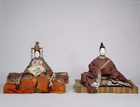Japanese Gallery (Honkan) Room 14
February 22, 2011 (Tue) - April 24, 2011 (Sun)
According to the old lunar calendar, the third day of the third month is the date of the peach blossom festival. Families traditionally celebrate this occasion by displaying hina dolls, which symbolize their prayers for the health and fortune of their daughters.
The origins of this tradition are unclear, but records reveal it had become an annual event by the early Edo period (1603-1868). The "Edo Kanoko" guidebook, written during the Jokyo era (1684-88), mentions hina doll markets being opened at several locations within Edo (present-day Tokyo), including Nakabashi, Owarimachi, Ningyocho, and Kojimachi.
During the first half of the Edo period, the main type of hina were standing dolls made of paper. Seated dolls in clothes combining vibrantly colored fabrics emerged after the mid-Edo period. Variations included:
| Muromachi-bina, with costumes in Muromachi-period style; | |
| Kyoho-bina, representing an imperial couple in richly layered costume; | |
| Jirozaemon-bina, with round white faces (favored in mid-western Japan); and | |
| Kokin-bina, long-faced dolls popular in Edo. |
Today, it is standard to display one set of Dairi-
bina
(based on Kyoho-
bina
) accompanied by dolls representing three court ladies, two high-ranking ministers, court officials without rank and a group of five musicians. In the late Edo period, however, ukiyo-e and other sources show that displays liberally combined multiple sets of Dairi-
bina
and
hina
dolls with other doll types, such as traditional Kyoto-style Gosho and Kamo dolls as well as lesser-known regional varieties. Delicately crafted, these dolls show the affection and tastes of their makers as well as their owners, reflecting the Japanese people's characteristic love of miniature objects.

